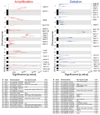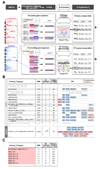Integrative analysis reveals an outcome-associated and targetable pattern of p53 and cell cycle deregulation in diffuse large B cell lymphoma
- PMID: 22975378
- PMCID: PMC3778921
- DOI: 10.1016/j.ccr.2012.07.014
Integrative analysis reveals an outcome-associated and targetable pattern of p53 and cell cycle deregulation in diffuse large B cell lymphoma
Abstract
Diffuse large B cell lymphoma (DLBCL) is a clinically and biologically heterogeneous disease with a high proliferation rate. By integrating copy number data with transcriptional profiles and performing pathway analysis in primary DLBCLs, we identified a comprehensive set of copy number alterations (CNAs) that decreased p53 activity and perturbed cell cycle regulation. Primary tumors either had multiple complementary alterations of p53 and cell cycle components or largely lacked these lesions. DLBCLs with p53 and cell cycle pathway CNAs had decreased abundance of p53 target transcripts and increased expression of E2F target genes and the Ki67 proliferation marker. CNAs of the CDKN2A-TP53-RB-E2F axis provide a structural basis for increased proliferation in DLBCL, predict outcome with current therapy, and suggest targeted treatment approaches.
Copyright © 2012 Elsevier Inc. All rights reserved.
Figures








References
Publication types
MeSH terms
Substances
Grants and funding
LinkOut - more resources
Full Text Sources
Other Literature Sources
Molecular Biology Databases
Research Materials
Miscellaneous

